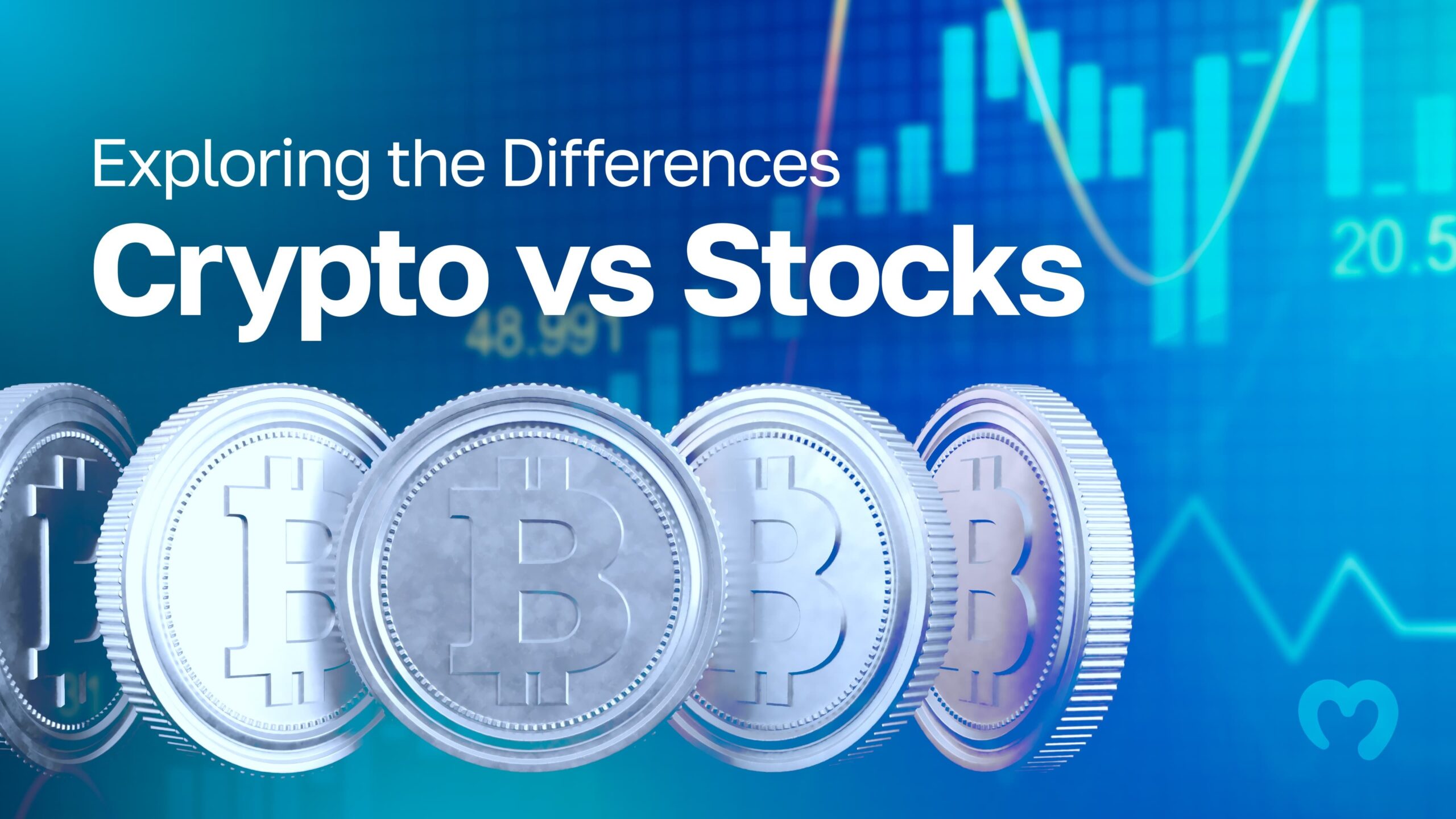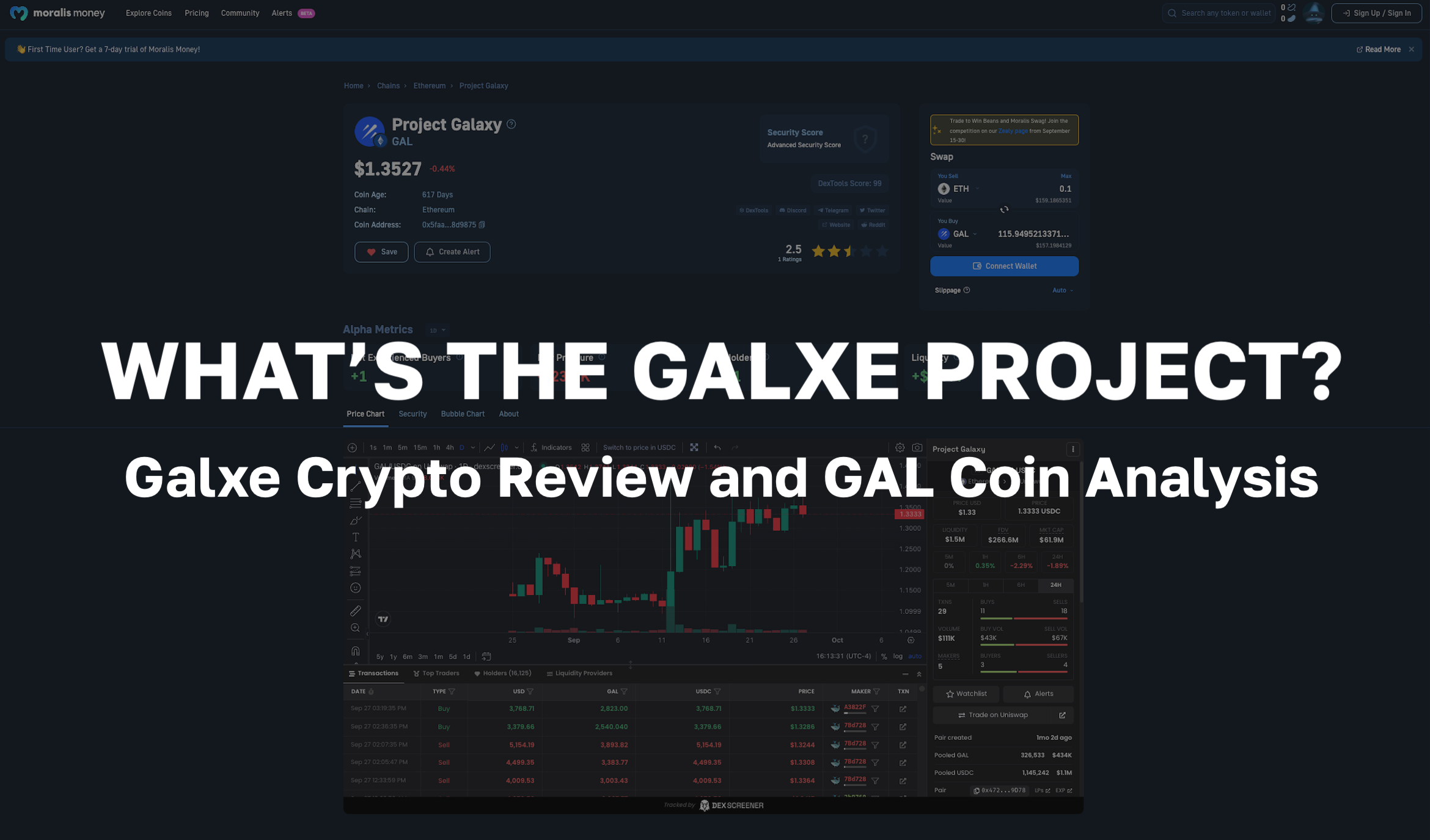Investment opportunities come in several forms. In some geographies, it is commonplace to use fiat currencies to invest in businesses and assets. Also, stocks and shares allow investors to speculate on the future earning potential of a business via fractional ownership. Furthermore, the crypto markets offer a wealth of investment opportunities in cutting-edge blockchain projects and decentralized protocols. Anyone familiar with stocks will likely notice the differences between traditional investing and crypto investing. However, there are several differences between these investment vehicles. So, before you start frantically searching for “crypto vs stocks”, read on!
In this article, we’re going to explore the key differences between crypto vs stocks. We’ll explore the defining characteristics of each asset class. Plus, we’ll discuss the various similarities between crypto and stocks to help you make better investment decisions. In addition, we’ll break down some of the key concepts to consider when investing in each of these assets.
When exploring Web3 and blockchain education online, Moralis Academy is the number one platform. If you’re new to the world of crypto, check out our Crypto for Beginners course. In this course, we teach students about the fundamental differences between Bitcoin, Ethereum, and altcoins. Also, we show you how to buy, sell, and trade crypto safely using an exchange account and store it using a hardware wallet. Join our community of over 30,000 students and kickstart your blockchain education with Moralis Academy! In addition, save our “Solana and Rust” and “Top 5 Crypto-Friendly Countries” articles for later reading!
What is a Blockchain?
Before we consider the differences between crypto vs stocks, let’s take a look at the underlying technology that powers cryptocurrency networks. Blockchain is a type of distributed ledger technology (DLT). It serves as a distributed database for cryptocurrency networks secured by a decentralized network of nodes. Further, each node has a copy of the same ledger of transactions. This allows participants to trust the fidelity and security of cryptocurrency transactions without the need to trust a third party or central authority.
Blockchains store transactional data in blocks. Each block has a maximum capacity. When a block reaches this capacity, it is appended to the blockchain and immutably interconnected with each previous block. Therefore, anybody attempting to defraud a blockchain network would have to manipulate every transaction in every block that came before the transaction they’re attempting to manipulate. Plus, they have to catch up to the latest block in the chain.
Because each node in the network has an identical record of transactions, they can quickly identify bad actors. Furthermore, each block has an immutable timestamp that provides a transparent, chronological order of events. Accordingly, a blockchain network can exist outside of the legacy financial ecosystem.
If you want to improve your understanding of blockchain and cryptocurrencies, check out the Blockchain & Bitcoin 101 course. In this course, we teach students about the fundamental concepts of Web3. This includes wallets, forks, smart contracts, consensus, and hash functions. Start your blockchain education journey today with Moralis Academy! Also, if you’re a Web3 developer and want to practice your programming skills, check out Moralis Projects. Here, we provide free BUIDL walkthroughs for a variety of decentralized applications (dapps)!
Consensus
A blockchain network needs a framework to enable nodes to agree on the validity of transactions. This is where consensus mechanisms come in. Consensus mechanisms are essential to public blockchain networks as they create financial incentives for nodes to act honestly. PoW (proof-of-work) and PoS (proof-of-stake) are the two most common consensus mechanisms.
Proof-of-Work (PoW)
PoW is a first-generation consensus mechanism used by Bitcoin, Ethereum, Litecoin, and several other prominent blockchains. It requires nodes called “miners” to compete against one another to solve a complex math puzzle. Also, Bitcoin PoW miners need specialized hardware to solve these puzzles. Plus, PoW mining requires substantial amounts of electricity.
The first PoW miner to solve the puzzle earns the right to add a transaction to their block. In return, they receive newly minted cryptocurrency in the form of block rewards for their contribution to the network. Any miner that attempts to defraud the network risks losing their block rewards and future earning potential. Furthermore, any bad actor would need to gain at least 51% of the overall computing power of the network to have a chance of attacking it.
Proof-of-Stake (PoS)
The PoS consensus mechanism aims to provide a sustainable alternative to PoW. Instead of requiring nodes to compete against each other by expending huge amounts of electricity, PoS nodes lock up crypto assets to secure the network and validate transactions. In return, those who stake can earn a portion of transaction fees. Also, PoS consensus makes blockchain networks less attractive to attackers.
Furthermore, PoS is easier to scale than PoW. This is because PoW blockchains grow exponentially and require more computational work as they increase in size. Also, PoS mining removes a great deal of competition from the mining process. Accordingly, PoS mining generally has a lower barrier to entry than PoW mining. Moreover, PoS mining is becoming more favorable than PoW due to the lower energy expenditure it provides. Anyone who wants to attack a PoS chain would need to have a stake themself which they would lose in the event of a successful attack.
What are Cryptocurrencies?
Cryptocurrencies are virtual digital currencies that use cryptography and computer science to prevent double-spending and counterfeiting. Generally speaking, the majority of cryptocurrencies are decentralized, meaning they have no single point of failure or central authority. Also, because cryptocurrencies such as Bitcoin (BTC) and Ethereum (ETH) exist on public blockchain networks, they can be transacted without intermediaries.
Cryptocurrencies are borderless and censorship-resistant. Also, central banks and governments cannot interfere with the supply and distribution of cryptocurrencies. Accordingly, crypto assets, such as Bitcoin, that have a finite supply often serve as a hedge against currency devaluation.
Another significant feature of cryptocurrencies is that they facilitate fast, inexpensive cross-border payments. Anyone with an internet connection can send crypto to someone else from anywhere in the world within minutes. Plus, the fees for sending crypto are usually far less than what you would pay for an international bank transfer.
There are multiple use cases for crypto assets. Some are purely speculative and serve only to gamify yield generation. Others serve specific functions for different projects. For example, an exchange token such as FTX Token (FTT) gives users trading fee discounts on the FTX exchange. Also, some tokens entitle holders to governance rights, allowing holders to vote on proposals to make changes to a blockchain protocol.
Cryptocurrencies allow investors to become their own banks. While this appeals to many, having complete control and ownership of assets is scary to some investors. That is why stocks are such a popular investment vehicle, and crypto is considered a high-risk investment.
What are Stocks?
Stocks, also known as “equities”, are a type of financial instrument that falls in the category of securities. A stock gives the owner fractional ownership of a corporation or company. Each unit of a stock is called a “share”. When you own a stock, you are entitled to a portion of that company’s assets and profits. Furthermore, investors can purchase stocks through a stock exchange or via private sales. Stocks make up a significant portion of many investment portfolios. Plus, they’re subject to strict government regulations to protect investors.
Companies issue and sell stock to raise capital for business operations. Stocks tend to outperform other investment classes and can help investors hedge against inflation. Also, stocks allow investors to gain fractional ownership of a company. For example, let's say that company "A" issues 1,000 shares. If Alice owns 200 of these shares, Alice has a claim to 20% of company A's assets and earnings.
However, shareholders do not own the corporations they hold shares in. Instead, they own the shares corporations issue. Because corporations can file taxes, own property, and borrow money, the law treats them as legal entities. Accordingly, corporations own their own assets, not the shareholders. In the example above, Alice's 200 shares in company A do not entitle her to spend 20% of company A's assets or take home 20% of the office furniture. This is called the "separation of ownership and control".
Shareholders often receive income in the form of dividends as a portion of the company's profits. Also, stock owners can vote in shareholder meetings. The more shares an investor owns, the more voting power they receive in such meetings. This enables majority shareholders to control several aspects of the business, such as who sits on the board of directors.
Crypto vs Stocks
Cryptocurrencies and stocks share many similarities. For example, both can be purchased via an exchange. Also, crypto and stocks can represent fractional ownership in a company or project. Furthermore, holding crypto assets and stocks can entitle you to vote in shareholder meetings. However, in the crypto world, this takes place in the form of voting on proposals via a decentralized autonomous organization (DAO).
When a company goes public, it may issue shares to generate investment via an initial public offering (IPO). In the crypto world, projects can issue "shares" in the form of "tokens" via an initial coin offering (ICO) or token launch event. Both act as funding rounds to incentivize early investors.
However, there are some key differences between crypto vs stocks. For example, crypto assets are highly volatile compared to stocks. An annual yield of 8-10% is expected for many investment portfolios. On the other hand, crypto assets generally yield much higher returns for a higher level of risk. Also, crypto exchanges operate around the clock, whereas stock exchanges are open during business hours.
Stock exchanges are subject to high levels of regulation to protect investors. Despite the increase in compliance and regulation frameworks in the crypto space, cryptocurrencies are largely unregulated in many parts of the world.
Despite the various differences, crypto and stocks share many similarities. Both are assets that investors and traders speculate about. Also, both asset types are affected by global events and geopolitical uncertainty. Whether you're trading cryptocurrencies, stocks, or commodities, a firm understanding of technical analysis will help you to remove emotions from your investments and make choices based on probabilities instead of a gut feeling.
Crypto vs Stocks: Exploring the Differences - Summary
Both crypto and stocks are instruments that enable investors to generate wealth. Generally speaking, crypto assets are more volatile than stocks. However, this added risk comes with the potential for increased rewards. In addition, crypto comes with technical risks. Interacting with decentralized finance (DeFi) protocols and smart contracts using a self-custodial wallet contains the risk of losing funds. On the other hand, stock brokerages and applications provide a much higher degree of protection against loss of funds.
Now that we've explored the differences between crypto vs stocks, you should have a firm understanding of how each asset class works. Any investor coming from the traditional "stock landscape" may be surprised when venturing into crypto investing. However, many investors are quick to see the similarities between crypto and stocks. Furthermore, crypto and stock exchanges share many of the same features when it comes to speculating on price movements. Plus, investors can purchase tokenized stocks on the blockchain using a crypto wallet. This often enables them to bypass the need for a stock brokerage account.
If you want to take your trading game to the next level, check out the Technical Analysis 101 course at Moralis Academy. This course teaches students how to interpret price movements and develop effective trading strategies. Also, we cover everything you need to know about technical analysis, including indicators, support, resistance, and candlestick patterns. Make the most out of every trade with Moralis Academy!
Also, don't forget to follow us on Twitter @MoralisAcademy! We'd love to hear your thoughts about crypto vs stocks. In addition, check out our "Why to Learn Web3 Development" and "MetaMask Tutorial" articles to further expand your understanding of blockchain and Web3.




